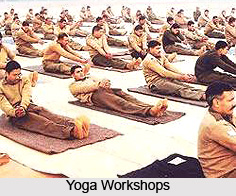 The tasya bhutnisu viniyogah yogic sutra describes about the usefulnesses of samyama in numerous spheres of everyday life. Such a potent assimilative power must only be attempted when one has become knowledgable in the much lower stages of meditation and yogic practice. A sudden skip is always injurious to the mind and health. Samyama has such an overmastering effect on one through integration, that he might be lead haywire.
The tasya bhutnisu viniyogah yogic sutra describes about the usefulnesses of samyama in numerous spheres of everyday life. Such a potent assimilative power must only be attempted when one has become knowledgable in the much lower stages of meditation and yogic practice. A sudden skip is always injurious to the mind and health. Samyama has such an overmastering effect on one through integration, that he might be lead haywire.
tasya its (samyama)
bhitmisu degree, step, stage
viniyogah application
Samyama can be applied in various spheres to derive its usefulness.
Patanjali explains that this insight and wisdom needs to be decently circularised in various spheres of one`s life.
Samyama can be applied in various spheres. In samadhi pada, concepts like pratyaya and various aspects of samprajnata samadhi and nirblja samadhi were explained (1.17-22 and 1.51). But one who has not mastered the lower stages cannot attain the higher, nor can he jump the intermediate stages. If eash stage is followed in turn, one becomes familiarised with them by degrees, and full insight develops.
Full insight may also dawn by the grace of God, won through one`s previous virtuous karmas. Vamadeva, Prahlada, Sukadeva and Ramakrishna in the past, and Aurobindo, Ramana Maharsi and Mahatma Gandhi of the present century were the great personalities who had the blessings of God and had attained fullness of knowledge.
This sutra affirms that no one can expect success or mastery without regular practice, and also warns one not to jump to higher stages of practice without first establishing a firm foundation through the primary steps of yoga.
There are several instances, even in modern literature, of people quite unexpectedly experiencing samyama even if they have been following no fixed path of yogic discipline. The Japanese refer to this sudden lifting of the curtain of ignorance as a `flash`. This is undoubtedly a moment of grace, but it is not the same as enlightenment. If the receiver of this sudden grace is sensible, he will go back to the beginning, find a suitable path, and follow it persistently even for many years, to construct consciously and by worthy effort, what had once been yielded in a moment of grace.
The modern fancy of `kundalini awakening` has probably arisen through these bizarre experiences of `integration`. Patanjali does not mention kundalini, but speaks of the energy of nature flowing abundantly in a yogi (iv.2). Kundalini is a neologism. This energy of nature (prakrti shakti) was originally known as agni or fire. Later yogis called this fire kundalini (the coiled one) as its conduit in the body is coiled 32 times at the base of the spine. It is, however, clear that many who undergo an overpowering experience of fusion with the universal consciousness reap, through their unpreparedness, more pain than benefit. To the lucky, healthy few, such an experience can serve as an incite to begin a true spiritual search, but to many others it can bring ruthless physical and psychological disorders. The eightfold path, although it may appear mystical to the uninitiated, is ultimately a path of spiritual evolution whose motto might well be `safety first`. The foundation must be secure, as Patanjali emphasises when he places yama and niyama first, and when he marks an explicit step up between asana and pranayama.
Vyasa has elucidated this sutra thus: `Yoga is to be known by yoga. Yoga is the teacher of yoga. The power of yoga manifests through yoga alone. He who does not become careless, negligent or inattentive, he alone rests in yoga and enjoys yoga.`
`Yogena yogojhatavya yogo yogatpravartate yo pramattastu yogena sa yogo ramate dram.`




















